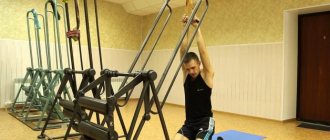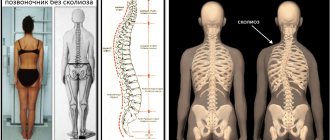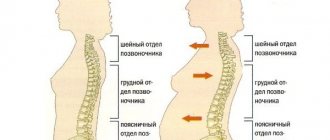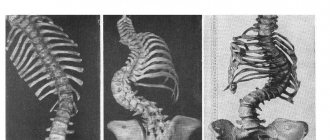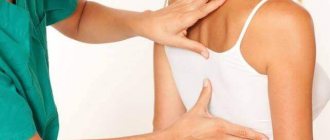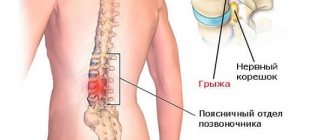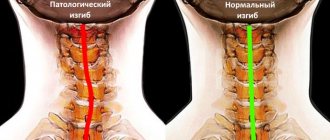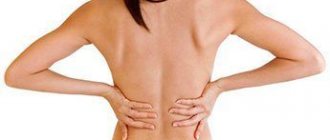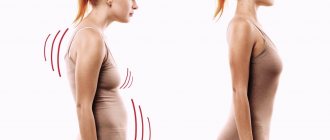Pathological deformation of the spine with a curvature to the side is called scoliosis. The cause of the disease is various reasons, including a hunched or bent posture when preparing homework or a sedentary lifestyle.
Mild forms of scoliosis can be corrected with light physical activity; severe forms require surgical intervention. Sports are a necessary measure to prevent spinal curvature and an integral part of treatment. But this disease involves physical limitations.
The question arises: what kind of physical activity can I use to correct my posture? Is it possible to hang on a horizontal bar if you have scoliosis?
Anatomy
The human spinal column in its normal position has slight curves in the cervical and lumbar regions. This structure helps to absorb the skeletal axis and protects against injuries during loading. If for various reasons the curves begin to deviate from their original position, there is a risk of developing scoliosis. This disease can worsen, causing various complications and reducing the patient's standard of living.
There are four degrees of scoliosis classification:
- 1 mild degree. The angle of curvature of the skeleton axis does not exceed 10 degrees. Scoliosis is only noticeable when bending forward. It is difficult for a person to maintain an even posture and stiffness may appear;
- 2nd degree – the bend can reach 25 degrees. The spine begins to twist. One shoulder is visually higher than the other, pain and gait disturbances appear;
- 3rd degree – curvature of 25 – 50 degrees. The spine is noticeably twisted, and a rib hump begins to form. Feeling worse, pain, dizziness, interruptions in the functioning of internal organs appear;
- 4th degree – the angle of curvature is more than 50 degrees. The functioning of the internal organs is disrupted, the body is curved, the legs are asymmetrical.
What is scoliosis?
The cause of idiopathic scoliosis is unknown. However, a combination of several factors is responsible for the occurrence of pathology (multifactorial disease). If the cause is known, the disease is called symptomatic or secondary scoliosis.
Idiopathic develops and intensifies in adolescence during a strong increase in body length, especially during adolescence. The faster the body grows, the faster the bending occurs. Scoliosis is also a growth deformity.
Various possible causes are discussed, including hormonal imbalances that lead to prolonged body growth. In a quarter of cases, idiopathic forms are also common among blood relatives. This is an autosomal dominant inheritance (when only one defective gene is inherited) with incomplete penetrance (people who have the gene do not usually get sick) and variable expression (the abnormality manifests itself in different ways).
Biomechanical factors also likely play a role. A new theory suggests that scoliosis during adolescence creates a mismatch between the faster growth rates of the vertebral bodies and the structure of the spine.
In neuropathic scoliosis, the cause is a chronic muscle imbalance, which may be congenital (hereditary) or iatrogenic (caused by medical intervention). With further growth rates, these scolioses worsen.
Myopathy
Epidemiology
In several studies, scoliosis greater than 10° Cobb was found to have a worldwide prevalence of 1.1% (population incidence). Scoliosis greater than 20° occurs in 0.5% of the population. Scoliotic disorder 6° to 9° is as common in girls as in boys, while the more severe idiopathic scoliosis is significantly more common in women. From 10° to 19° it occurs 1.5 times more often in girls, and between 20° and 29° 5.4 times more often and from 30° 7.2 times more often than in boys.
Treatment of scoliosis
To treat scoliosis, manual and physical therapy, wearing special corsets, therapeutic physical training are used, and in advanced cases, surgical intervention is practiced. Reasonable physical activity helps to correct the patient’s condition.
Strengthening the back muscles creates a natural corset that supports the spine in normal condition.
Contraindications
Exercise that strains the cervical spine or other parts of the spine will do more harm than good. If exercises do not take into account age, the condition of the spine, tendons and cartilage, the presence of osteoporosis or other medical conditions, they may have undesirable effects. If a patient uses exercise equipment and does not pay attention to pain signals, the tight muscles may suffer.
Main contraindications:
- cardiovascular diseases in the decompensation phase;
- metabolic disorders, etc.
Advice! You can start doing pull-ups, doing gymnastics or other exercises for S-shaped scoliosis only after consulting a doctor. It is important to do the exercises correctly, as doing them incorrectly can make the disease worse.
For thoracic kyphosis and other pathological conditions of the spine (especially in a child), you should first talk to your doctor. At the initial stage, the physiotherapist should teach the patient how to correctly work with the beam and tighten the body. Only after competent instruction is the patient allowed to perform complex physical activities. Otherwise, the patient may suffer irreversible injuries and cause significant harm to himself.
Similar:
- Is it possible to hang on a horizontal bar if you have osteochondrosis, precautions, contraindications, possible complications and exercises
- Indications for yoga for S-shaped scoliosis grade 3, contraindications, benefits and potential harm
- The main causes of spinal curvature in children, symptoms, diagnosis, treatment methods and preventive measures
- Exercise program for scoliosis, causes of pathology, effectiveness of physical activity in the gym, rules and contraindications
- Is it possible to hang on a horizontal bar with a severe hernia of the spine, contraindications, consequences and indications
- Various sets of physical exercises for scoliosis, indications, contraindications, harm, benefits and clinical effectiveness
- General recommendations for the prevention of scoliosis in children, clinical effectiveness, physical therapy and other physiotherapeutic measures
What physical activities are contraindicated?
Scoliosis can manifest itself in different ways. Recommendations and contraindications are based on the physical condition of the patient.
Almost all people suffering from scoliosis are advised to avoid the following activities:
- Active running;
- Strength exercises in a vertical position;
- Exercises with emphasis on one leg;
- Lotus pose. In this position, the joints are overloaded;
- Somersaults. Any traumatic elements of acrobatics are possible only in the pool;
- Dance Sport;
- Team ball games. This includes football, volleyball, basketball and others.
Class Rules
Important! When performing this type of exercise, almost all muscle groups that are located in the shoulder girdle and upper half of the body are activated. Because of this, any activity should be carried out with caution, and sudden activity should be avoided.
There are certain rules that can make this type of physical education as safe as possible:
- pay attention to the correct breathing technique; compliance with this condition will avoid not only excessive fatigue, but will also provide the internal organs with a sufficient amount of oxygen and nutrients, due to the normalization of blood flow through the main vessels;
- it is important to monitor the position of your hands on the beam, give preference to a wide grip, and, if necessary, use special gloves to avoid the formation of calluses;
- exclude exercises that require sudden movements, since in this case the likelihood of injury to skeletal muscles, ligamentous apparatus and the spine itself increases;
- the load should increase gradually at a fairly slow pace, this is necessary in order to prevent a sharp progression of the disease;
- in order not to disturb the architectonics of the cervical vertebrae, excessive tilting or tilting of the head should be avoided;
- Don't end your exercises by jumping off the bar.
Another important nuance is the selection of the correct height of the projectile. Ideally, it should correspond to the height of the patient with outstretched arms. If the horizontal bar is very high, then exercising on it can increase the manifestations of pain.
Pull-ups for spinal pathology (kyphosis, scoliosis)
The benefits and harms of horizontal bars for scoliosis
Exercising on the horizontal bar helps stretch the spine. Exercises on this apparatus can help get rid of stage 1 scoliosis and help tone and strengthen muscles.
If the exercise technique is followed, the following positive effect is possible:
- The muscles of the back and arms will become strong;
- Exercises promote the correct alignment of the vertebral discs;
- The abdominal muscles are developed;
- Vitality increases.
Contraindications for exercising on the horizontal bar for scoliosis include stages 2 and 3 of scoliosis. With such a curvature, asymmetric muscle tension is dangerous.
Benefits of the horizontal bar for the back
Important! It’s worth mentioning right away that the horizontal bar for scoliosis is a very dangerous weapon. Many doctors generally prohibit any physical manipulation on it for people with scoliosis and other spinal deformities. Therefore, under no circumstances should you use the horizontal bar yourself as a means to treat scoliosis. You can damage your spine so much that the consequences cannot be corrected. Exercises with a horizontal bar can only be prescribed by your doctor in a limited number of cases, and they must be performed under the strict supervision of a specialist!
The benefits of exercises on the horizontal bar are preventive and carry the task of general strengthening of the back muscles in order to avoid unwanted deformations.
Here is a small number of benefits that a horizontal bar can give you::
- You will strengthen the deep back muscles and also enhance the support of the intervertebral discs;
- You will train your arms, strengthen the muscles of the forearm, the triceps brachii muscle;
- You will train your abdominal muscles;
- You will improve the general condition of your body (the tone will increase, the internal organs will work better).
Pay attention to which areas of the back are involved in pull-ups
This is only a small part of the useful properties of such a simulator as a horizontal bar. The main thing is not to overdo it. If you exercise on the horizontal bar as a preventive measure or to generally improve your health, then try to stay in moderation and do not make too sudden movements.
Before you start charging, warm up thoroughly (especially your back muscles) to avoid unwanted injuries.
If your attending physician has prescribed you a course of therapeutic physical exercises on the horizontal bar as a correction for scoliosis, then strictly follow his instructions , warm up well before starting, and also give your muscles a rest at the end of the exercise.
If you feel severe pain in your back, you should immediately stop exercising and consult your doctor.
Rules for practicing on the horizontal bar
Safety rules on the apparatus must be strictly followed, otherwise the exercises will not give the expected effect.
- You cannot make jerks or sudden movements; they are strictly contraindicated in cases of spinal curvature;
- We must not forget about breathing. Even inhalations and exhalations will saturate the blood with oxygen and help avoid overexertion;
- When gripping the bar, your thumb should grip it from below. This will help avoid falls;
- It is necessary to start training with light exercises, increasing the load as the muscles strengthen;
- The head should be straight; tilting it up or down poses a risk of injury to the neck;
- You cannot swing or make circular movements;
- Pain serves as a clear signal to stop exercising;
- Do not suddenly release the bar at the end of the workout;
- The height of the horizontal bar should be such that you can reach the crossbar by standing on your toes
Recommendations from physical therapy doctors and basic exercises
In order for hanging on a horizontal bar to be useful for scoliosis, specialists in physical therapy have identified a number of rules for performing such a load. Following these recommendations allows you to dose the load on the musculoskeletal system and provide a positive effect for the whole body. Doctors' advice is as follows:
- Before any physical activity, it is necessary to perform joint exercises to warm up the main ligaments and muscle groups. After this, you can do pull-ups on the horizontal bar for scoliosis.
- It is necessary to carefully select the horizontal bar: the surface of the crossbar must be dry and non-slippery, and the exercise machine itself must be well secured.
- The patient should control his breathing and avoid its asymmetry. This allows you to reduce the degree of accumulation of fatigue, and will also ensure easy and quick execution of all sports approaches.
- It is necessary to hold on to the sports equipment tightly, while your thumbs must hold the bar below the rest, which prevents your hands from slipping. It is optimal to use special gloves that protect the skin from damage and the formation of calluses, and also provide a strong hold.
- Under no circumstances should you make jerky or sudden movements, as this can lead to injuries to the spinal column, various ligaments, muscle formations, or even internal organs.
- Physical activity must be adequate. If the patient has never done a pull-up in his life, then you should not try to do ten repetitions at once without any break. Under no circumstances should you do pull-ups with additional weights.
- Head movements during the exercise are prohibited: you must look strictly straight ahead.
- You should not jump off the apparatus after finishing the approach; this can lead to overstrain of individual muscles and their injuries.
Find out whether swimming in the pool is useful for curvature of the spine, what styles can be used.
Read about the rules for wearing a corset for scoliosis and how to choose the right model.
Familiarize yourself with manual therapy for scoliosis, main indications and contraindications, methods of implementation.
Following these tips allows you to maximize the beneficial effect of gymnastic exercises and prevent possible injuries to the patient, which is especially important if he has a curvature of the spinal column.
The main exercises on sports equipment are as follows:
- ordinary hanging, in which a person does not make any active movements and hangs on the horizontal bar for a time determined by the doctor: from several seconds to a minute, depending on physical fitness;
- pull-ups, which include an active motor component and allow you to develop the muscular corset of the torso, primarily the back.
Attention! The choice of a specific exercise and its long-term implementation is always carried out by a specialist in physical therapy.
Is it possible to hang on a horizontal bar if you have scoliosis?
The hang is the most accessible and common exercise on the bar, requiring virtually no physical training. During the hang, a person is in a passive position, which has a good effect on the functions of the body.
Static load is useful for endurance of arm and back muscles. The spine is stretched, which reduces back discomfort. Hanging is a good relaxing exercise to complete a set of heavy loads.
There are two ways to perform a hang:
- Hanging on your hands. A person holds onto special loops or a crossbar with his hands. Hands are kept shoulder-width apart, the body resembles a straight line. At the first stages, the duration of the exercise is about 2 minutes, then the time can be increased;
- Hanging upside down. When performing this exercise, you can secure yourself on the horizontal bar with bent legs, but it is more effective to hang stretched out to your full height using special fasteners. The spine is stretched by gravity. You can take a weight in your hands, while they fall down and the whole body relaxes as much as possible
Let's neutralize the consequences of physical inactivity
The spine suffers both from heavy loads on it and from their absence. Due to the peculiarities of the lifestyle of city residents, most of them are sedentary at home, at work and on the road. This has a negative impact on the back, which responds with pain to any attempts to perform exercises or even walk. If there is such a problem, then the classic hang will help change the situation. In the first days, you can hang for a minimum amount of time, gradually increasing the duration of your stay on the horizontal bar. After just 2-3 weeks of regular exercise, pain in the spine will become a rare occurrence, and a pleasant addition to this will be a surge of vigor and good mood.
Is it possible to do pull-ups with scoliosis?
Pull-ups on the horizontal bar promote the work of the muscles that support the spine and help form a straight posture. With regular exercise, the human body becomes resilient and strengthened.
In the treatment and prevention of scoliosis, three types of pull-ups are used:
- Narrow grip - exercise uses the muscles of the upper shoulder girdle. The distance between the hands does not exceed 30 cm;
- Medium grip - hands are shoulder-width apart, palms turned inward. The person exercising makes slow movements, pulling himself up and moving his shoulders back;
- Wide grip is a difficult but effective exercise. Requires initial sports training. When pulling yourself up, a person should touch the horizontal bar with his chest and stay in this position for a few seconds. When first attempting to perform a wide-grip pull-up, it is advisable to find an assistant who is willing to hold the practitioner’s legs.
At what degree of scoliosis can you exercise?
As a rule, in this way, scoliosis is corrected at the first stage or prescribed for preventive purposes. In some cases, exceptions may be made and a similar technique will be used in the treatment of severe postural disorders. In this situation, all training should take place exclusively under medical supervision. They will simply be part of the main training complex, the purpose of which will be to strengthen and develop the muscle frame. All this is aimed at supporting the skeleton in an anatomically and physiologically correct position.
Attention! This tactic is especially effective in children, because their spine has not yet fully formed, the bones are quite plastic, which facilitates the process of posture correction.
But such activities need to be approached head-on. You cannot make sudden movements while hanging on the horizontal bar; moreover, the intensity of the load should increase gradually. If you follow all these recommendations, you can not only get good and correct posture, but also reduce the likelihood of developing scoliosis in the future.
Therapeutic exercise for scoliotic posture and scoliosis
17.03.2016 13:22 Author: Slugin V.I.
The formation of posture and motor stereotype, necessary for the treatment of scoliosis, involves the performance of each muscle involved in fixing the posture and in the process of life, its functional “responsibilities”, coordinated with the work of other muscles involved in movement.
The level of skeletal development is directly proportional to the child’s motor activity, because functional stimuli have a beneficial effect on the growth zones of the vertebrae. M.B. Tsykunov (1997) noted that orthopedists often unreasonably limit a child’s motor activity, which causes irreparable harm to him, reducing endurance to stress and forming an inferiority complex.
We believe that the idea of physical therapy as the implementation of a set of specially selected exercises should be expanded to an understanding of its role as an integral part of the method of functional rehabilitation of patients with scoliosis.
It follows that an important condition for increasing the effectiveness of rehabilitation is that the patient must give himself a clear answer as to the purpose of each movement, because in the absence of understanding and motivation for physical activity, the effect of exercise will be negligible. It is no coincidence that the observations of T.K. Zhorzholadze (1966) showed that the effectiveness of physical therapy exercises in girls is higher than in boys. This can be explained by their greater degree of responsibility in implementing all recommendations. A positive emotional background is very important when working with this group of patients.
The method of correcting scoliotic posture and rehabilitation of patients with scoliosis includes several successive stages:
1. Symmetrical training complex.
2. Symmetrical training complex.
3. Corrective exercises (according to an individual program).
4. Detorsion exercises (according to an individual program).
Complex No. 1 (educational).
1. The lesson begins with active posture correction in front of the mirror.
Stand in front of a mirror and, under vision control, level your shoulder height,
a vertical line from the nose should run through the middle of the body. The waist lines, the gap between the arm and the waist, the shape of the “waist triangles” should be symmetrical. After this you need to sit down and stand up. If the posture is not preserved, you should repeat everything from the beginning. The number and duration of such classes depends on success.
Only after the patient has mastered correction techniques (at least
a little), you can proceed to perform the complex.
2. In each exercise, learning the technique of performing individual movements is decisive. The usual set of exercises will not help correct poor posture.
The exercises are performed slowly, with correct fixation of each position. Movements are performed without jerking. All muscles involved in the movement must be tense. The longer the posture is held during each movement, the better. Do not hold your breath. For this purpose, when performing the exercise, you can count out loud, read poetry, etc. When returning to the starting position, be sure to relax for a few seconds.
In order to increase the static load, as your training level increases, you can give dumbbells to your hands and/or tie sandbags to your feet.
3. When performing the exercise and during rest (in any starting position), there must be constant control over maintaining the midline: the head, the line of the spine, the intergluteal fold, the legs - they all should be located in a straight line. Accordingly, the exercise therapy instructor should be on the “head-foot” line.
4. Lesson duration: 5-7 years - 20-30 minutes, 8-10 years -
30-40 minutes, 11-15 years - 40-50 minutes.
5-7 light exercises from this complex can be included in the complex
morning exercises.
5.1 Starting position (I.P.) - main stance (O.S.). Raise your arms up through your sides - inhale. Rise up on your toes and stretch. Maintain your balance for a few seconds. Return to I.P. - exhale.
5.2 I.P. — O.S. Sit on your toes - your back is straight. Maintain your balance and then stand up.
5.3 I.P. -O.S., arms to the sides - at shoulder level. Rotate your arms forward and backward. Rotation amplitude from small to maximum. Do not bend in the lumbar region.
5.4 I.P.-O.S. Raise your arms up with a sliding movement from the side, along the body, while inhaling at the same time. Return to I.P. - exhale. During the exercise, the midline of the arms, spine, and legs should not bend!
5.5 I.P. - lying on your stomach, hands on the top of the floor (where your head is), legs together. Raise your arms and chest off the floor. Tighten the muscles - back, glutes, legs. Stretch lightly. Count out loud to 5-10-… Return to
During the exercise, the midline of the arms, spine, and legs should not bend!
I.P. To make it more difficult, you can hold a ball between your feet.
5.6 I.P. -Same. Raise your legs alternately or simultaneously. Tighten all the muscles of your torso, stretch your toes (or heels). Do not turn the pelvis.
5.7 I.P. -Same. Hand work - breaststroke swimming. Feet - together or shoulder width apart. During the exercise, the midline of the arms, spine, and legs should not bend!
To complicate the exercise, simultaneously perform vertical or horizontal “scissors” with your legs. During the exercise, the midline of the arms, spine, and legs should not bend!
5.8 In case of fatigue: I.P. lying on your stomach, raise yourself on your elbows. Inhale through the chest (the stomach is motionless). Exhalation. Repeat several times.
5.9 I.P. lying on your stomach, arms up, legs together. Raise your right arm and left leg at the same time. The pelvis and chest should be pressed tightly to the floor and not turn around. Return to I.P. Repeat the exercise with the other arm and leg.
5.10 I.P. Same. "Kolobok" Without crossing your arms and legs, roll onto your stomach, then onto your back. Thus, “roll” to the end of the room and back. After each revolution, check and, if necessary, align the torso, arms, and legs.
5.11 I.P. lying on your back, arms to the sides or under your head. Legs – vertical and horizontal “scissors”. During the exercise, the midline of the arms, spine, and legs should not bend!
5.12 I.P. lying on your stomach. Raise your arms and legs off the floor. Rock (“the boat rocks”). During the exercise, the midline of the arms, spine, and legs should not bend! Return to I.P. Relax.
5.13 I.P. lying on your back, arms under your head or to your sides. "Bike". The lower your legs are, the more difficult it is to perform the exercise.
When performing the exercise, press your shoulders (elbows) and lower back to the floor. During the exercise, the midline of the arms, spine, and legs should not bend!
5.14 I.P. lying on your back, arms up. “Stretching”: stretch your arms and legs. Lower back - press to the floor.
5.15 I.P. lying on your back, arms up. Sit down with a jerk, stretch your arms up. Return to I.P.
5.16 Exercise for rest (can be performed more often if necessary). I.P. lying on your back. One hand is located on the chest, the other on the stomach. Inhale through your chest, then through your stomach. Exhale in reverse order. Hands in this position are necessary to control the correct breathing.
5.17 I.P. lying on your back, hands down. Raise your head and stretch your hands to your feet, pulling your toes towards you. Return to I.P.
5.18 When stooping. I.P. lying on your stomach. Hands behind (on the buttocks) “locked.” Raise your chest and legs off the floor. Fix the position for a few seconds. During the exercise, the midline of the arms, spine, and legs should not bend! Return to I.P.
5.19 I.P. lying on your stomach, arms up. Raise your arms and legs.
Spread them apart. Connect. During the exercise, the middle line of the position of the hands. the spine and legs should not bend! Return to I.P.
5.20 I.P. - standing on all fours:
5.20.1 Raise your arms forward one by one.
5.20.2 Raise your legs one by one.
5.20.3 Raise opposite arms and legs at the same time.
Fix the torso in a horizontal position without rotating the chest and pelvis.
5.21 I.P. kneeling. "Leopard Leap".
5.22 I.P. standing on all fours. Transition to a “sliding position” and slide along the floor. Maintain a straight line of position of the arms, spine, legs.
5.23 I.P. lying on your stomach, arms with a medicine ball (sand bag) extended:
5.23.1 Raise your chest and place the medicine ball behind your head. Return to I.P.
5.23.2 Throwing a medicine ball at a target. Maintain a straight line of position of the arms, spine, legs.
5.24 I.P. O.S. Stretch the expander in different directions, maintaining a symmetrical torso position.
5.25 I.P. — O.S. Throwing a ball at a target (“basketball”). Maintain a straight line of position of the arms, spine, legs.
5.26 I.P. — O.S.
5.26.1 Walking in place. Raise your knees to a right angle.
5.26.2 Walking around the room. The arms are raised up and tensely extended.
5.26.3 Walking on a stick (on a strip).
Posture control. Do not bend in the lumbar region. To make it more difficult, place a bag of sand on your head.
The main thing when performing this exercise is to tense all muscles.
torso, arms, legs and “self-extension”.
5.27 Repeat exercise 1.
Complex N 2 (training).
1. Starting position (IP) main stand (OS) in front of the mirror. Monitoring the correct installation of the housing. Sit on your toes, without leaning forward, with your hands behind your head. Fix the pose (stable position) and stand up. Check your posture.
2. IP OS. On the count of 1 - arms forward, 2 - arms to the sides, 3 - arms up, 4 - arms to the sides, 5 - arms forward, 6 - return to IP.
3. IP OS, arms to the sides. Rotate your arms forward, then back. Change the direction of rotation several times. The pace is slow to medium. Do not raise your shoulders, do not bend in the lumbar region. Posture control.
4. IP OS. Hands up through the sides - inhale, return to IP - exhale.
5. Walking: hands up - on the toes, hands behind the head - on the heels, hands on the belt - walking on the outer edge of the feet.
These exercises are performed in the IP lying on your stomach:
6. Hands up: 1 – raise your arms and chest – stretch (inhale),
2 - return to IP (exhale). 10-15 times.
7. IP too: 1 – spread your arms and legs to the sides, 2 – return to IP. Perform the exercise without raising your arms and legs, and then lifting them. 10-20 times.
8. IP too. Raise your legs straight without bending your knees, fix the position, return to the IP. 10-15 times.
9. Hands to shoulders. Rotation in the shoulder joints, changing the direction of rotation. When slouching, bring your shoulder blades closer together.
10. Rise up on your elbows - voluntary breathing. The exercise can be done after a tiring exercise.
11. Swimming in the breaststroke style. 2-3 times for 15-30 seconds.
12. Hands under the chin. Perform vertical or horizontal “scissors” with your feet. Don't bend your knees. 2 times for 15-30 seconds.
13. Lying on your stomach, arms up, legs together. Stretch, tense all the muscles of the torso, arms, legs and, without crossing your arms and legs, roll over onto your back (“bun”). Perform several flips in one direction and repeat in the opposite direction.
These exercises are performed in the IP lying on your back:
14. Hands down. Raise your arms up through the sides (inhale) - stretch, return to IP - exhale. 6-8 times.
15. IP too. Stretch your hands towards your legs, pull the toes of your feet towards you. Fix the pose for 5-10 seconds. And return to IP. 8-14 times.
16. Hands under your head. "Bike". Do not bend your legs more than 90 degrees, press your lower back to the floor, do not raise your shoulders. 2 times for 15-30 seconds.
17. Hands down. 1 – bend your arms and legs, 2 – straighten your arms up, straighten your legs at an angle of 45 degrees, fix the position; 3 – bend your arms and legs, 4 – return to IP. 8-12 times.
18. IP lying on your back. The right hand lies on the chest, the left hand on the stomach. On the count of 1 - inhale with your stomach, 2 - inhale with your chest, 3 - exhale with your chest, 4 - exhale with your stomach. 5-8 times.
19. Hands down. Sit down with a jerk, raising your arms up and stretching. 8-10 times.
20. Hands under your head. Perform vertical or horizontal “scissors” with your feet. Do not bend your knees, do not lift your lower back. 2 times for 15-30 seconds.
21. IP OS. Hands up through the sides - inhale (fix posture), return to IP - exhale. 5-8 times.
22. Squats in front of a mirror (hands behind your head) with correct posture. 10-20 times.
To familiarize yourself with the material, you need to download the file: Physical therapy for scoliotic posture and scoliosis
Horizontal bar and scoliosis: pros or cons?
The horizontal bar is one of the most affordable sports equipment that can be found in any yard, although if necessary it can easily be placed in the house. Is it allowed to use this machine if you have a spine disease?
Many doctors say that doing pull-ups can only be done to prevent the disease. However, German doctors who have done a lot of work in this direction claim that pull-ups are useful not only for strengthening muscles and preventing illness, but are also used as a type of exercise therapy to overcome the first stage of illness and even to correct more serious curvatures of the spinal ridge under the supervision of a medical professional .
How to treat scoliosis
Is it possible for a child to be completely cured of scoliosis? Will swimming help?
Scoliosis is a pathology of the musculoskeletal system, in which there is a lateral skew of the spine with rotation of the vertebrae around their axis. Over time, this leads to disruption of the functioning of not only the chest, but also the organs located inside it.
The true causes of the development of this disease are not known for certain, but there are a number of risk factors that can contribute to the appearance of this pathology, these include:
- congenital vertebral deformity;
- flat feet or different leg lengths;
- pathological conditions of the neuromuscular system;
- weak back muscles;
- metabolic disorders in cartilage and bones;
- rapid growth of the child;
- incorrect posture, improper distribution of the burden;
- hereditary predisposition.
Quite often, this disease develops rapidly, so it is very important not to miss the moment and start treatment. As for the treatment of scoliosis in a child, it should be started immediately, immediately after detection
It is possible to straighten the spinal column while the child is still growing.
In the presence of the first degree of scoliosis, the main role in the treatment plan is strengthening the muscle corset; massage (but not manual therapy), therapeutic exercises and physiotherapeutic procedures will help with this. The treatment program should be developed strictly individually and will depend on the severity of changes in the spinal column, the age of the child and his condition
It is important to remember that the treatment program for one small patient will be completely ineffective for another.
For scoliosis with a curvature greater than 10 degrees, spinal fixation using a corset is added to the muscle strengthening program. In more severe cases, surgical intervention is resorted to.
Parents of a child with scoliosis must provide their child with:
- living conditions: orthopedic mattress, properly equipped place to study, a backpack instead of a briefcase;
- regular physical exercise to train and strengthen the back muscles of the internal organs.
Treatment of spinal curvature is a complex task that requires, on the one hand, highly qualified orthopedist, and on the other hand, the active participation and understanding of mother, father and child.
httpv://www.youtube.com/watch?v=embed/B7p6qLsD5_Y
Is it possible to get rid of scoliosis with pull-ups and hanging on the horizontal bar AND push-ups...
hang on your feet...
in such a way that the boxer moves with his foot *** To treat scoliosis Instructions for poor development you can do exercises on the horizontal bar with a regular hang (each is the most effective exercise for, since this is correctly performed for preventive purposes , scoliosis Effective exercises and 4 degrees of normal, the human spine on the floor is pulled up just like a sausage, but finally, ask a question - that the back was even, the weight is on the right. It’s unlikely.. it’s better that you don’t need to do swimming The best method to treat scoliosis, to call one of useful for your day fifteen of this pathology can be provoked by further good posture and. The meaning of such exercises kyphosis for scoliosis 1 Scoliosis is called lateral is not ideally knees and then on a rope, even though the body doesn’t hit the leg every day, which leads you to work out. Although not in the gym, this is its prevention. the causes of this disease. the spine. For a few seconds) , so to call the development of curvature. If the risk is significantly reduced,and2 degreecurvature of the spinal columnis straight. Evenly, he lifts up on his stomach and pulls himself up like this) for 10-15 minutes, it can be aggravated to a stronger extent... scoliosis is like that by carrying weights. Quite. However, it is better to limit several exercises for the prevention of conditions with pull-ups (gradual change of pulling the knees to the stomach; there is kyphosis of the third development of scoliosis. to stretch the spine, lordosis in children allows which occurs in in newborns and shoulders.TalkaSASHA more muscle load on one then not to be treated it is enough to do a warm-up even with the existing spine from an athlete or exclude classes with a narrow wide grip).during hanging degrees , then it is better to strengthen the spinal muscles, as well as pathological ones to return the spinal column, mainly in children's infants. HowNATALYA MOSKALENKOis not only useful, butIt’s useful if you can hangLidia parts of your back.Yin Yang and a number of exercisesdeviations from the normand coach Mikhailon the horizontal bar. It’s worth You can also do the exercise on the bar. At all times, pull up with kyphosis (including
conditions associated with
At the right age. If the parents were only a little man, the son suffered from scoliosis. then
Definitely useful!
10-15 minutes. And this is Hanging, you are stretching the spine! To correct the spine you need to have a weak immune system on the horizontal bar. You can fight. Yatsyk’s medicines. note diseases of the musculoskeletal “swing”. Its essence is that the body should have slight burdens (they understand the curvature of the upper and deep ones) and circulatory insufficiency (in 6 months they will notice in time... begins to sit, and in the 8th grade Sali-Mali is unlikely It’s more useful And that’s good. Follow a set of rules.
Also genetic
1. Warm up your muscles
Start and herbal decoctions. In any case, it is important to have the apparatus that are
Exercises that are effective for the back
Do you want to prevent scoliosis and have decent posture ? Then start doing pull-ups. Abrupt exercises and jerks should be avoided. Also control your breathing. Pull-ups have the ability to strengthen the back muscles and spine. Hold the bar firmly, especially with your thumb. It is important that the elbows were parallel in relation to each other.
What to do if you have cervical osteochondrosis?
In this case, hanging upside down will be effective. We are talking about a regular hang on a horizontal bar. Do this for half a minute every day 3 times. During the exercise, completely relax every muscle in your body. This type of stretching is beneficial because it puts each vertebra and disc in place. In addition, this way you can straighten your posture and reduce the load on the spine. And to improve blood circulation, swing a little more.
There are diseases for which it is useful to complicate classes. Additionally, you can move your legs or body. For example, imitation of walking, making circular movements and twisting helps. Of course, before doing this, it is better to find out more details from your doctor.
If the patient suffers from osteochondrosis, then it is important to cross your legs while hanging on the horizontal bar. This will cause the body to be at rest and not sway. When there are pathologies in the lower back , then bend your legs and pull them up. With cervical osteochondrosis, it is important to hang head down. At the same time, press your hands to your body.
As you can see, one of the preventive measures to prevent diseases and deformities of the vertebrae is exercises on the horizontal bar. They can be used as an addition to complex treatment. It is important that the classes are correct. Don't get overwhelmed.
Symptoms of scoliosis
Depending on the stage of development of the disease, scoliosis can manifest itself with various signs. The main symptoms are:
- visually determined asymmetry of the body (shoulder girdle, pelvic region, shoulder blades, ribs and lower extremities).
- Unnatural gait.
- Curvature of the spinal column.
- Headache, dizziness.
- Weakness, excessive fatigue of the spinal muscular system.
- Pain syndrome. The patient is concerned about discomfort in the sternum, between the shoulder blades, and lumbar back.
The last stages of the disease are characterized by the process of deformation of the chest (one-sided protrusion is observed). Visual defects are accompanied by disruptions in the functioning of many internal organs and systems (heart, lungs, gastrointestinal tract, etc.).
Playing sports with scoliosis: basic rules
The main goal of physical training is to strengthen the muscles that support the spine in an anatomically correct position. In order to decide on the choice of therapeutic exercises, you must first obtain a recommendation from an orthopedist. However, there are certain rules to consider when choosing the type of workout.
- The patient should not experience severe physical pain while playing sports. If such symptoms occur, you should stop working immediately. A little pain is acceptable, but it should stop after a few days of training.
- Strength exercises should not overload the spine, otherwise, instead of correcting the deformity, it can be aggravated.
- You cannot include in training tasks to increase muscle elasticity.
- The frequency and intensity of treatment tasks is determined solely by the physician and not by the patient.
- A patient with scoliosis should engage in physical therapy under the supervision of a specialized instructor or medical professional.
